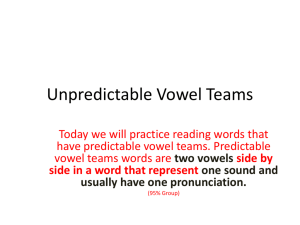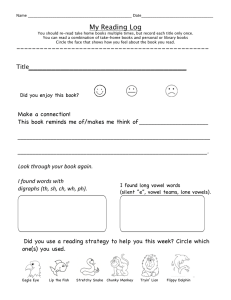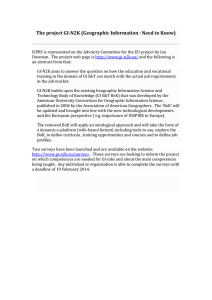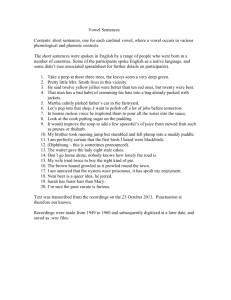Opaque interactions with rules and constraints Linear
advertisement
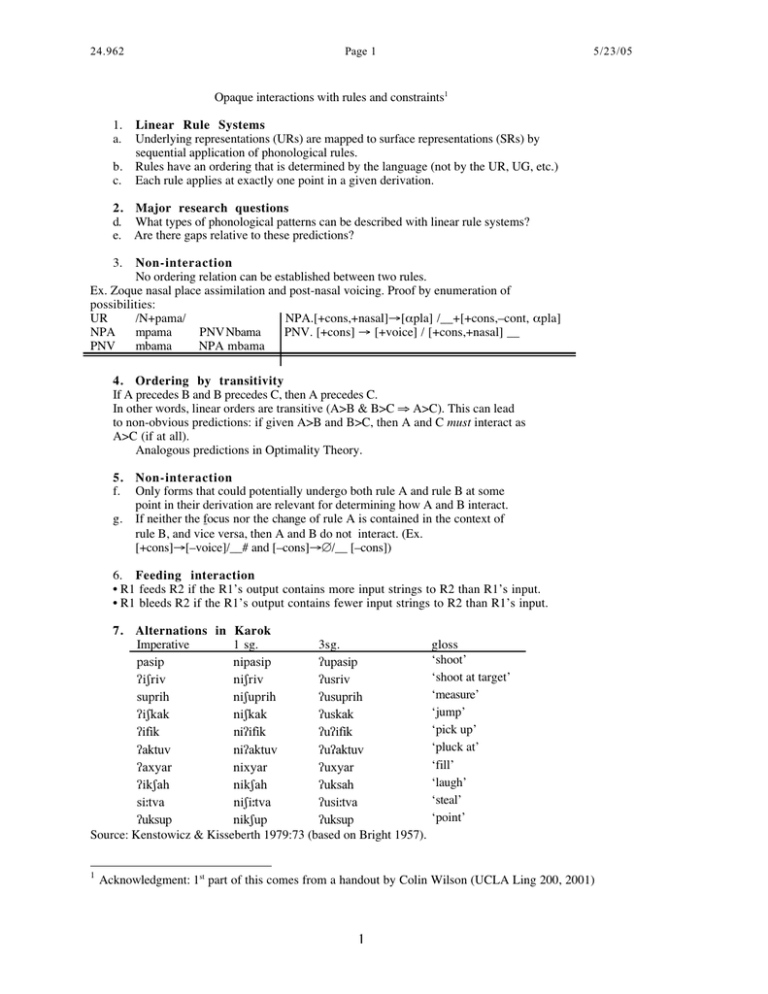
24.962 Page 1 5/23/05 Opaque interactions with rules and constraints1 1. Linear Rule Systems a. Underlying representations (URs) are mapped to surface representations (SRs) by sequential application of phonological rules. b. Rules have an ordering that is determined by the language (not by the UR, UG, etc.) c. Each rule applies at exactly one point in a given derivation. 2. Major research questions d. What types of phonological patterns can be described with linear rule systems? e. Are there gaps relative to these predictions? 3. Non-interaction No ordering relation can be established between two rules. Ex. Zoque nasal place assimilation and post-nasal voicing. Proof by enumeration of possibilities: UR /N+pama/ NPA.[+cons,+nasal]Æ[apla] /__+[+cons,–cont, apla] NPA mpama PNV Nbama PNV. [+cons] Æ [+voice] / [+cons,+nasal] __ PNV mbama NPA mbama 4. Ordering by transitivity If A precedes B and B precedes C, then A precedes C. In other words, linear orders are transitive (A>B & B>C fi A>C). This can lead to non-obvious predictions: if given A>B and B>C, then A and C must interact as A>C (if at all). Analogous predictions in Optimality Theory. 5. Non-interaction f. Only forms that could potentially undergo both rule A and rule B at some point in their derivation are relevant for determining how A and B interact. g. If neither the focus nor the change of rule A is contained in the context of rule B, and vice versa, then A and B do not interact. (Ex. [+cons]Æ[–voice]/__# and [–cons]Æ∅/__ [–cons]) 6. Feeding interaction •R1 feeds R2 if the R1’s output contains more input strings to R2 than R1’s input. •R1 bleeds R2 if the R1’s output contains fewer input strings to R2 than R1’s input. 7. Alternations in Karok Imperative 1 sg. 3sg. gloss ‘shoot’ pasip nipasip ?upasip ‘shoot at target’ ?iSriv niSriv ?usriv ‘measure’ suprih niSuprih ?usuprih ‘jump’ ?iSkak niSkak ?uskak ‘pick up’ ?ifik ni?ifik ?u?ifik ‘pluck at’ ?aktuv ni?aktuv ?u?aktuv ‘fill’ ?axyar nixyar ?uxyar ‘laugh’ ?ikSah nikSah ?uksah ‘steal’ si˘tva niSi˘tva ?usi˘tva ‘point’ ?uksup nikSup ?uksup Source: Kenstowicz & Kisseberth 1979:73 (based on Bright 1957). 1 Acknowledgment: 1st part of this comes from a handout by Colin Wilson (UCLA Ling 200, 2001) 1 24.962 Page 2 5/23/05 8. Rules for Karok with example derivations UR /ni+uksup/ Vowel Deletion. VÆ∅ / V__ niksup feeding Palatalization. sÆS / i(C)__ nikSup Onset epenthesis. ∅Æ? / #__V /u+iksah/ uksah n/a ?uksah bleeding • This example shows that a rule feeds or bleeds another rule only with respect to a particular form . The same is true of other types of interactions discussed below. 9. Counterfeeding and counterbleeding R1 counterfeeds R2 if (a) the output of R1 has more potential inputs to R2 than its input And (b) R2 does not apply to the inputs created by R1 R1 counterbleeds R2 if And (a) R1 has the potential to make strings ineligible for R2 application (b) R2 applies anyway to those strings. 1 0 . Alternations in Yawelmani (Yowlumne) Yokuts gloss nonfuture perfective future passive xathin ‘ate/eats’ xatmi ‘having xatnit ‘will be eaten’ ‘eat’ eaten’ ‘find’ bok'hin bok'mi bok'nit ‘tangle’ xilhin xilmi xilnit ‘lead by the hand’ dubhun dubmu dubnut •Other nonfutures: maxhin ‘procures’, k'o?hin ‘throws’, giy'hin ‘touches’, hudhun ‘recognizes’ dubitative participative gerundive gloss ‘eat’ xattaw ‘eating’ xatal ‘might eat’ xatxa ‘let us eat’ ‘find’ bok'ol bok'xo bok'tow xilal xilxa xiltaw ‘lead by the hand’ dubal dubxa dubtaw •Other dubitatives: maxal ‘procure’, k'o?ol‘throw’, giy'al ‘touch’, hudal ‘recognize’ Vowel harmony. A vowel is pronounced round (and back) if the immediately preceding vowel is a round vowel that has the same height specification. Alternative environment: ‘an V V C 0 __ [ahigh] Æ [+round] / [ahigh] [ahigh, +round] vowel in [+round] preceding syllable’. nonfuture saphin doshin lanhin mek'hin wonhin Shortening. V˘ Æ nonfuture c'omhun future sa˘pen do˘sen la˘nen me˘k'en wo˘nen imperative sapk'a dosk'o lank'a mek'k'a wonk'o dubitative sa˘pal do˘sol la˘nal me˘k'al wo˘nol gloss ‘eat’ ‘report’ ‘hear’ ‘swallow’ ‘hide (trans.)’ A vowel is shortened before a sequence of two or more consonants. V / __CC dubitative c'o˘mal Alternative environment: ‘in a closed syllable’. gloss ‘destroy’ nonfuture do˘shin 2 dubitative do˘sol gloss ‘reports’ 24.962 Page 3 5/23/05 so˘ghun wo˘?yuhun so˘gal wo?yal ‘pull out a cork’ ‘falls asleep’ wo˘nhin so˘nihin wo˘nol sonlol do˘lulhun dollal ‘might climb’ ho˘tinhin hotnol Lowering. V˘ ‘hide’ ‘pack on the back’ ‘takes the scent’ A long vowel becomes [–high]. Æ [–high] Epenthesis. [i] is inserted between the first two members of a triconsonantal cluster. ∅ Æ i / C __ CC Source: Kenstowicz & Kisseberth 1979:77-99, which is based on Newman (1944). 1 1 . Example derivations for Yawelmani: non-opacity-inducing interactions UR /dub+hin/ /bok'+al/ /do˘s+k'a/ Vowel Harmony dubhun bok'ol do˘s+k'o Lowering —— —— —— Shortening —— —— dosk'o 1 2 . Example derivations for Yawelmani: opacity-inducing interactions UR /c'u˘m+hin/ /su˘g+al/ Vowel Harmony c'u˘mhun —— two examples of counterfeeding Lowering c'o˘mhun so˘g+al counterbleeding Shortening c'omhun —— 1 3 . Additional Yawelmani data: deverbal nouns noun form gloss UR noun form gloss ‘finding’ ‘getting tired’ bok' /bok'/ moyin ‘stealing’ ‘falling’ ?ut' /?u˘t'/ ?utuy ‘getting hungry’ /?i˘dl/ ‘falling asleep’ ?idil wu?uy ‘pulverizing’ logiw /logw/ UR /mo˘yn/ /?uty/ /wu˘?y/ The first vowel of this type of deverbal noun is required to be short — a type of prosodic template — and this requirement allows proposed underlying [high] values to surface (because Lowering can’t apply). a. b. c. 1 4 . Opacity: Kiparsky (1971, 1973: in Kiparsky Explanation in Phonology, Foris 1982) A phonological rule P of the form AÆB/C__D is opaque if there are surface structures with any of the following characteristics: instances of A in the environment C__D. (counterfeeding interactions yield this) instances of B derived by P that occur in environments other than C__D (counterbleeding yield sthis) instances of B not derived by P that occur in the environment C__D. 1 5 . Two preliminary classifications of opaque interactions a. motivated by anti-merger considerations: opaque interactions preserve an underlying contrast, whereas corresponding transparent ones do not. E.g. As a result of the opaque interaction between RH and Lowering, Yokuts c'omhun is uniquely recoverable as /c'u˘mhun/. A transparent interaction of RH and Lowering would have yielded [c'omhin], indistinguishable from UR /c'omhin/ or /c'o˘mhin/. b. motivated by distantial faithfulness: one class of counterfeeding scenarios preserve a smaller distance between Input and Output than corresponding feeding scenarios. 3 24.962 Page 4 5/23/05 E.g. aÆ e, eÆ i, iÆj/_V, all 3 applying in counterfeeding order, in Basque (Kenstowicz and Kisseberth1978). Measured in F1 distance, the actual UR-SR mappings compare as follows with the UR-SR mappings of the transparent interaction: /a/ a. b. Transparent Æ /e/ Æ /i/ Æ [j] [j] [j] /a/ Æ Opaque [e] /e/ Æ [i] /i/ Æ [j] opaque interactions that do allow recovery of the interacting constraints/rules …. that don’t. 1 6 . No recovery: Polish (Sanders UCSC diss 2002) Final devoicing counterbleedsV-Raising; V-Raising not learned. (a) Final Devoicing klub-I klup t˛Ekav-I t˛Ekaf kçlE)nd-a kçlE)nt dva raz-I ras talE-E talEß grI¸-Eß grI˛ bEg-u bEk ‘club (PL/SG)’ ‘ready (regular/short form)’ ‘Christmas carol (NOM SG/GEN PL)’ ‘twice/once’ ‘plate (PL/SG)’ ‘bite (2SG/IMP)’ ‘edge (GEN/ACC)’ (b) Raising stemUR /dvçr/ /bçl/ /pçkçj/ /stçw/ NOM SG dvur bul pçkuj stuw NOM PL dvçrI bçlE pçkçjE stçwI gloss ‘mansion’ ‘ache’ ‘room’ ‘table’ /ur/ /ul/ /vuj/ /muw/ ur ul vuj muw urI ulE vujE muwI ‘a kind of sour soup’ ‘beehive’ ‘uncle’ ‘mule’ /tßçp/ /kçt/ /vwçs/ /wç˛/ /sçk/ /grçx/ /dçm/ /tßçn/ /kç¯/ tßçp kçt vwçs wç˛ sçk grçx dçm tßçn kç¯ tßçpI kçtI vwçsI wç˛E sçk±i grçxI dçmI tßçnI kç¯E ‘peg’ ‘cat’ ‘hair’ ‘elk’ ‘juice’ ‘pea’ ‘house’ ‘trunk’ ‘horse’ 4 24.962 Page 5 5/23/05 (c) Opaque interaction of Raising and Devoicing /bçb/ bup bçbI ‘bean’ /rçv/ ruf rçvI ‘ditch’ /lçd/ lut lçdI ‘ice’ /dçvçz/ dçvus dçvçzI ‘supply’ /nç/ nuß nçE ‘knife’ /rçg/ ruk rçgi ‘horn’ 17. R u l e s • ç-Raising: ç -> u / ___ [C,–nasal,+voice] # • Devoicing: [–sonorant] -> [–voice] / ___ # counterbleeds Raising 1 8 . Exceptions, loans stem UR /kçlçr/ NOM SG kçlçr *NOM SG *kçlur NOM PL kçlçrI gloss ‘card suit’ /xçl/ /parasçl/ /kçvbçj/ /grutßçw/ /glçb/ /snçb/ xçl parasçl kçvbçj grutßçw glçp snçp *xul *parasul *kçvbuj *grutßuw *glup xçlE ‘lobby’ parasçlE ‘umbrella’ kçvbçjE ‘cowboy’ grutßçwI ‘gland’ glçbI ‘globe’ /EpJizçd/ /kçd/ /nEkrçlçg/ /prçlçg/ /rEkçrd/ /fJçrd/ EpJizçt kçt nEkrçlçk prçlçk rEkçrt fJçrt *snup *EpJizut *kut *nEkrçluk *prçluk *rEkurt *fJurt snçbI ‘snob’ EpJizçdI ‘episode’ kçdI ‘code’ nEkrçlçgi ‘obituary’ prçlçgi ‘prologue’ rEkçrdI ‘record’ fJçrdI ‘fjord’ 1 9 . An experiment with forest creatures •2 subjects. •Stimuli: plurals of Polish sounding non-words like szlapogy (‘szlapogs’) embedded in sentences •Task: form the singular, where the voiced C is in final position. • Example stimuli bardzo ¬adne zênabody da¬y Jankowi kawe¶, nie herbate¶ bardzo ¬adne szlapogy da¬y Jankowi kawe¶, nie herbate¶ ‘The very pretty zênabods (szlapogs, ...) gave John coffee, not tea.’ •Example target sentences : Jeden bardzo ¬adny ______ pozyczy¬ Jankowi i pienia¶¶dze, i koszule¶ ‘One very pretty ______ lent John both money and a shirt.’ •Results: the V-height in the zênabod, szlapog forms is in the same category as the V-height of the plurals. Raising does not apply to nonce forms. •Sanders’ Moral: Raising is not part of the grammar. 5



